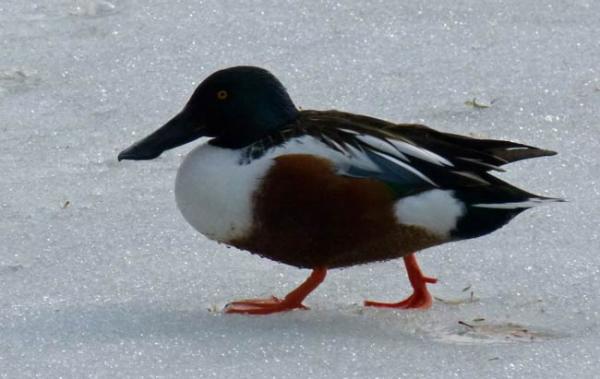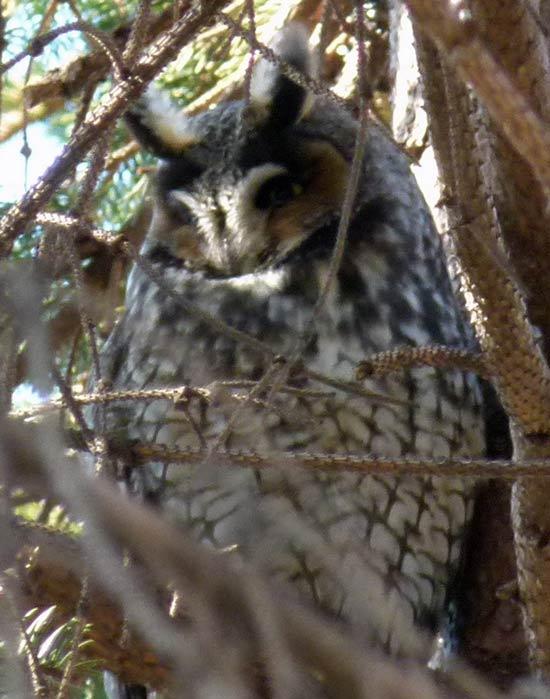Birding for Beginners: A Novice Gets Tips from the Pros


NEW YORK CITY To the uninitiated, the enthusiasm of birders for their chosen pursuit can come as a bit of a surprise. Birders are passionate folk. But to a non-birder and a skeptic, the allure of looking for and at birds can be downright elusive. However, a word of warning: when discussing birding with one of its disciples, don't call it a hobby.
"That sounds like model trains," said ornithologist Paul Sweet. "The term 'hobby' seems to trivialize it. It's one of the major molding forces of my life."
Sweet, not only a bird scientist but also a lifelong bird watcher , has been leading bird walks in Central Park for more than five years, and on a recent weekday, Sweet was conducting his last winter walk of the season.
The instructions were to meet at the statue near 77th Street, across from the American Museum of Natural History, which runs the bird walks. Sweet is the Collections Manager of the institution's vast stock of bird specimens. ("Kind of like being a librarian of bird specimens," Sweet explained.)
Spotting birders
At the appointed corner, a bust of German naturalist Alexander von Humboldt bare-chested and heroically well-muscled glowered out over a heap of extremely dirty snow, the only reminder, on an unseasonably warm afternoon, that it was still mid-February.
One could immediately pick out the birders milling around the snowbound statue binoculars were a dead giveaway.
Get the world’s most fascinating discoveries delivered straight to your inbox.
As people drifted up in ones and twos, those already gathered spoke in raised voices over the din of traffic whizzing up and down Central Park West.
The buzz among the birders was last week's sighting of a varied thrush.
"Oh, it was just beautiful! And so cooperative!" said one woman.
Sweet explained that varied thrushes are extremely rare in this part of the country. The bird must have gotten lost on migration and flown east instead of south from the Pacific Northwest where the birds are native.
Sweet, himself a native of Bristol, England, migrated west to New York about two decades ago. He said aside from the recent sighting, he'd seen a varied thrush only once before, ten years earlier.
There were high hopes for a second encounter, and further excitement when the scientist mentioned that long-eared owls might be in the neighborhood.
Before we set off, there was a brief discussion of new binocular purchases. Sweet, an affable man with an efficient manner, glanced over a computer printout one woman produced from a coat pocket. "The specs look good," Sweet said. "How heavy are they?"
Moments later, Sweet, dressed in dark jeans, a hard-bound Sibley bird guide sticking out of his jacket pocket, delivered an official welcome to the dozen-or-so gathered, and everyone trooped into the park.
Standing in the ... road
The birding began almost laughably fast. Immediately, a red-tailed hawk was spotted.
For the best view, it was necessary to stand in the road. "Watch out for bikes!" Sweet warned, as cyclists swerved around the strange group gawking up into the trees.
The large bird, which Sweet identified as a juvenile by markings on its tail feathers, placidly sat in the bare branches. It was a thrilling sight. And with the proffer of a pair of binoculars, the thrills increased tenfold.
Suddenly, a close-up view of a magnificent face a raptor's face was revealed. Each feather, each gradation of grey and brown and rust, the sculpted curve of a beak, each sharp movement of a wild creature, sprang into razor-sharp focus. The observer gasped. These people were onto something.
With each successive magnified view on the two-hour ramble that took us up and down hills, across meadows, around lakes, through the woods, all the while squelching through various stews of mud and leaves and ice and grass and concrete, the allure of the exercise grew.
Shoveler ducks, tufted titmice, English house sparrows ("He's an immigrant like me," joked Sweet), red-bellied woodpeckers, goldfinches, a rarely-seen siskin, a yellow-bellied sapsucker there was no shortage of wonders to surprise and delight a novice.
Through a pair of field glasses, a bird that would normally never get a second glance was astoundingly beautiful, a riot of color and shape and line. The binoculars offered entrée to a secret world that one could go a lifetime without seeing, even though it is, quite literally, in front of one's face.
The only disappointment was a fruitless search for the long-eared owl. Our trek to a stand of pines was all for naught.
On a foray into the woods, near a series of bird feeders, our group came upon some fellow birders outfitted with serious cameras and camouflage.
The two groups, obviously well-acquainted, exchanged greetings and friendly conversation. One baseball-capped gent, his foot propped jauntily on a bench, said, "Did you hear about the owls?"
The word on the street was, they were still around, and this guy knew where: the boathouse.
Sweet turned to the group. "Who has time for an owl?" he said.
"We all do!" somebody yelled. It was true. Nobody was going to miss out on an owl. We were on a mission.
'Really incredible'
Ten minutes later, we filed to the top of a hill among a small circle of tall conifers. Everyone was silent, hopefully scanning the branches. Finally one woman pointed up into the trees.
Without binoculars one could see what looked like an extremely large pine cone. But through the lenses, there it was a long-eared owl, the tufts of its feathers ruffled slightly by a breeze, its eyes dark and mysterious.
One regular among the birders, Jeanette Holmes, her thick auburn ponytail tucked under an army cap, turned to the beginner in the group and spoke in a low voice. "It's really incredible we get to see this today," she said. "Owls are special."
Owls aren't native to the area, and Sweet said we were lucky to see one. Like so many visitors to New York, the owl was just passing through.
The afternoon's expedition was coming to an end, but one elusive quarry remained.
After another ten-minute walk, Sweet stopped. "Look, look. Right there. Do you see it?" he said.
The bird hopped among the sparrows and tufted titmice, a delicate, long-legged creature marked with streaks of pale pumpkin orange and brownish-grey. It was the varied thrush.
The small bird flitted about, now on a pile of snow, now on a log, now in the crook of a rock, a rare and hidden treasure next to an equipment shed, where a van was haphazardly parked, and the buzz of a wood chipper filled the air.
- Nationwide Bird Count Takes Flight This Weekend
- Birders Rejoice: Library Puts Avian Calls, Photos and Maps Online
- In Images: Bald Eagles of the Mighty Mississippi
Reach Andrea Mustain at amustain@techmedianetwork.com. Follow her on Twitter @AndreaMustain.





